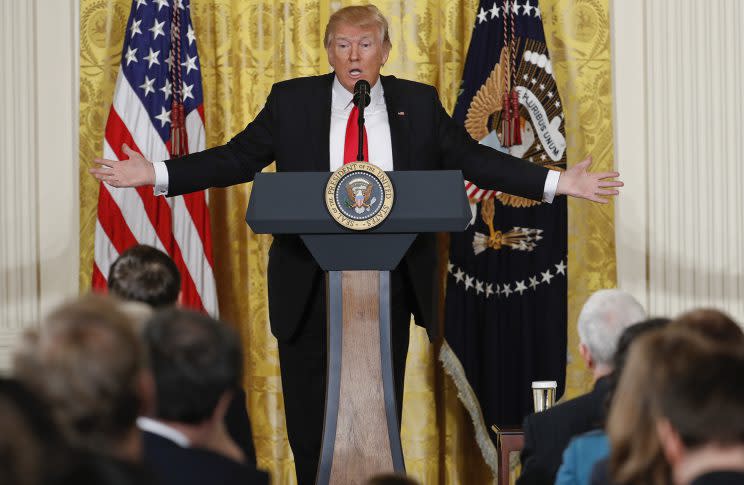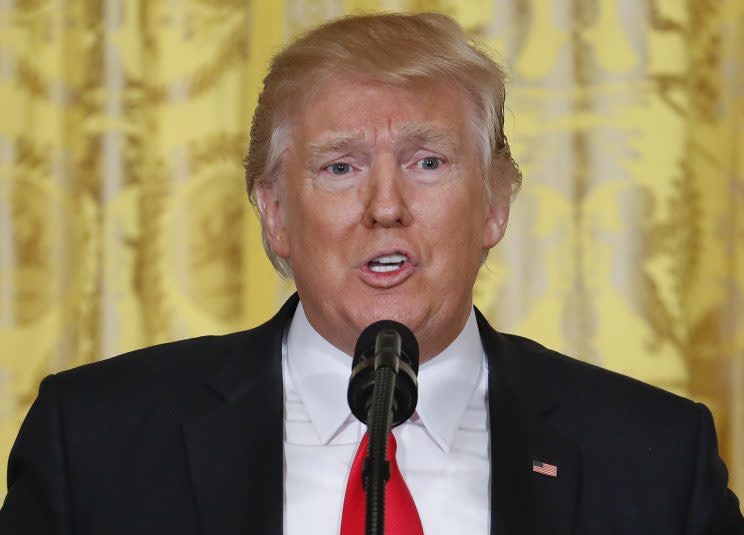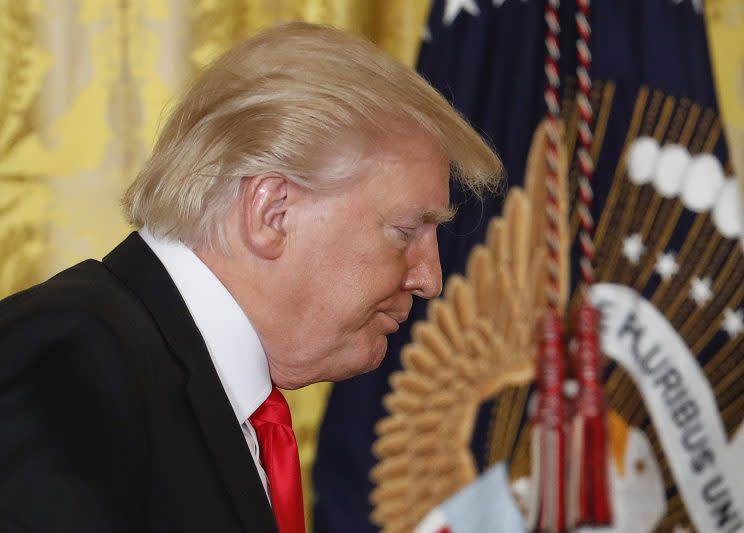President Trump hasn’t faced the White House press corps since February: Why it matters

WASHINGTON — The White House press office has taken heat in recent weeks for curtailing the daily briefings by press secretary Sean Spicer or his deputy, but as his administration has attacked the media as “fake news,” the West Wing has also quietly cut back on another channel of communication: question-and-answer sessions with the president himself. Previous presidents have responded to questions from reporters at regular news conferences. It’s a practice Trump has largely abandoned.
In his five months in office, Trump has held far fewer solo news conferences than any of his predecessors dating back to President Reagan. These sessions are the only way for the entire press corps to directly question the president, and Trump has had just one of them since taking office, on February 16.
Martha Joynt Kumar is the author of multiple books on the White House press shop. She’s also the director of the White House Transition Project, a nonpartisan group of academics who compile interviews with key staffers and conduct analyses of White House offices. Kumar, who has been studying the presidency since late 1975, has also exhaustively compiled statistics on the daily activities of the president. Kumar provided Yahoo News with data showing that Trump meets the press much less often than any other president in recent history.
By Kumar’s statistics, Trump’s lone press conference in office compares with three by George W. Bush and Ronald Reagan (as of June 24 in their first years — and Reagan was shot and wounded during that period), seven by Barack Obama and Bill Clinton, and 12 by George H.W. Bush.
Trump has held 10 joint press conferences with foreign leaders, which is comparable to previous presidents. However, those joint appearances are far different than solo news conferences. Traditionally, at news conferences with a foreign leader, each head of state will pick two reporters from their country to ask questions. As a result, these events feature just four questions from pre-selected reporters rather than the lengthy questioning that comes with a solo news conference. At Trump’s last joint press conference, with Indian Prime Minister Narendra Modi on Monday, the pair didn’t take any questions at all.
In a conversation with Yahoo News, Kumar explained the effect the virtual elimination of solo presidential news conferences has on the White House press corps.
“The only press conferences he’s done are the joint ones, so what then happens is, what you all need most is, you need the voice of the president, and you need that on a regular basis, and you haven’t had it,” said Kumar.
CBS News chief White House correspondent Mark Knoller has covered every commander in chief since Gerald Ford and has become known as the “keeper of the lists” for compiling extensive records on the president’s activities. Knoller also tracks presidential press conferences and confirmed Kumar’s data on Trump’s appearances. Knoller talked to Yahoo News about the difference between solo press conferences and the joint events with foreign leaders favored by Trump.

“Trump has had 11 news conferences, of which 10 have been joint news conferences with foreign leaders,” Knoller said. “What that means is usually just one or two questions each side. So, you know, they’re abbreviated in the number of questions he has to face, and he’s only had one full-length solo news conference as president.”
Knoller described solo press conferences as “an invaluable opportunity for the person elected as head of the nation to answer questions.”
“They’re an opportunity for more than just a couple of reporters to ask the president questions on a variety of issues that the press office is often unable or unwilling to give an adequate answer on,” said Knoller. “The only way to get to the president is either to be granted an interview, which is rare, or to get called on at a press conference.”
Yahoo News asked White House press secretary Sean Spicer why Trump has cut back on solo news conferences and whether he will hold another one soon. Spicer responded with an email stating that the president has spoken to the press through other venues.
“The president has engaged with the media in several ways, including print and TV outlet specific interviews as well as larger press conferences,” Spicer said.
Solo and joint conferences are the only times the president faces the full White House press corps, but it’s true that they aren’t the only ways the commander in chief engages with reporters. Kumar identifies three categories of interactions with the press, including news conferences. There are what she calls “short Q&As” where the president either calls an individual reporter on the phone, speaks with traveling press gathered on his plane, takes shouted questions from the press pool, or even has an off-record meeting with reporters. And there are formal interviews to individual news outlets. In each of these categories, Trump has lagged behind his immediate predecessor.
“He’s done fewer interviews, fewer short question-and-answer sessions, and fewer press conferences as well,” Kumar said of Trump. The disparities aren’t as great as with press conferences — as of June 18, Trump had 24 short Q&As, compared with 25 for Obama, and gave 59 interviews to Obama’s 64. By the same date in 2001, George W. Bush had 64 short Q&As and 29 interviews.
But Kumar also said the president has recently been cutting down on these other interactions with the press.
“In Trump’s case, he did a lot of short Q&As in his first 100 days, but he hasn’t been doing them since then,” Kumar explained. “And since he’s been reluctant to do those, he’s cut back his interviews as well.”
Of course, Trump’s avoidance of the press has come at the same time that the White House has cut back on briefings, which are the only other way for the press to get unscripted official policy statements. In the administrations of Obama and George W. Bush, briefings were held regularly each week and televised. This month, Trump’s team has barred cameras from many briefings, shortened their length and skipped the briefing entirely on many days. Kumar called it an “unprecedented” dry spell.
In the briefings that have been held, White House press staff have dodged questions on a variety of issues including climate change, the Senate health care bill and even the president’s golf habits by claiming they haven’t discussed them with the president. Those questions would be far harder to dodge if Trump was facing them himself.
Overall, Knoller, CBS’ chief White House correspondent, said it’s up to the public to decide whether this is a concern.
“There’s nothing in the Constitution that says he’s got to have news conferences, but yes, he has fewer and has had fewer than his recent predecessors, certainly of the solo full-length news conference, where it’s open to everybody,” Knoller said of Trump.
“We keep track of it and I certainly report it,” Knoller continued. “And the American people have to make a judgment if that’s the kind of president they want or whether it bothers them that he’s not answering our questions. Because our questions, by and large, are really the questions of the American people.”

Read more from Yahoo News:


